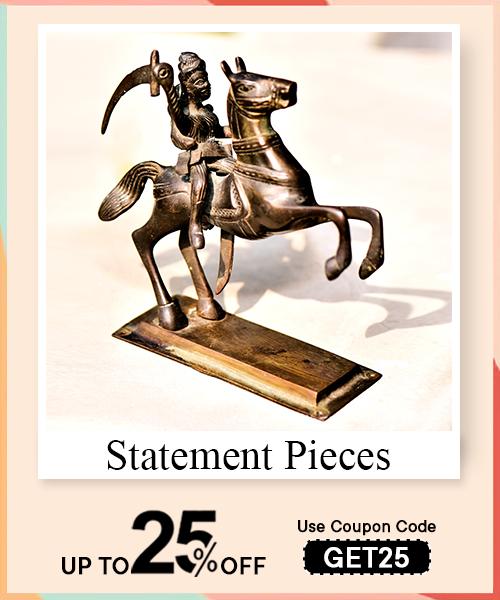The Tanjore art derives its resources and takes inspiration from way back in 1600AD when art was encouraged by the Nayakas of Tanjore under the domain or rule of Vijayanagara Rayas. They inspired classical art and music, mainly literature in Tamil and Telugu, and motivated the painting of Hindu religious subjects and elements in temples.
The most significant characteristic of Tanjore art is its use of precious metal, which is Gold. Tanjore paintings originated in the Maratha court of Thanjavur. These paintings were recognized as the geographical indication in India in 2007-08.
Tanjore paintings are characterized by rich and vivid colors, simple iconic composition, glittering gold foils overlaid on delicate but extensive gesso work, and inlay of glass beads and pieces or very rarely precious and semi-precious gems. In Thanjavur paintings, one can see the influence of Deccani, Vijayanagar, Maratha, and even European or Company painting styles. Essentially serving as devotional icons, the subjects of most paintings are Hindu gods, goddesses, and saints. Tanjore paintings are panel paintings done on wooden planks and hence referred to as palagai padam (palagai means "wooden plank"; padam means "picture") in local parlance. In modern times, these paintings have become souvenirs for festive occasions in South India.
Tanjore paintings depict many instances from Jain, Sikh, Muslim, other religious, and even secular subjects.
Read more : RADHA KRISHNA PAINTINGS: CAPTURING THE ETERNAL LOVE BETWEEN TWO LOVERS
Tanjore art has a unique place in the history of Indian Paintings. It originated in the 11th century when it housed in the Chola dynasty as a part of Chola wall paintings in Brihadeeswarar temple. The Tanjore painters migrated after the fall of the Vijayanagar empire and the sack of Hampi in the battle of Talikota in 1565. The migrated Tanjore artists went to Thanjavur and worked under the patronage of Thanjavur Nayaks. Following this, the Maratha rulers who defeated Thanjavur Nayakas began to nurture the Thanjavur atelier (a designer’s workshop). The artists absorbed the local influences and the individual tastes of their Maratha patrons, which helped evolve the unique Thanjavur painting style. In addition to decorating temples, the Thanjavur artists began painting and decorating the significant buildings, palaces, chatrams, and residences of the Maratha kings and nobility.
The rulers and nayakas of the earlier time played a significant role in the creation of Tanjore paintings. Raghunatha, possibly the most successful Thanjavur Nayaka ruler, was a great patron of art and artists and helped establish the unique school of Thanjavur artists who later evolved the Thanjavur style of paintings under the Marathas. It was during Achyutappa's reign the Vijayanagara empire fell, leading to the departure of numerous litterateurs, philosophers, musicians, and artists who migrated to several other neighboring kingdoms like Mysore and Thanjavur.
In Maratha, Serfoji II had to fight off a spirited competition from Amarasimha, his paternal uncle, to the Maratha throne of Thanjavur. It was during his reign that Tanjore paintings flourished and reached the form and style in which we recognize it today. Serfoji II had to traverse a problematic path throughout his reign, constantly challenged by Amarasimha, who ran a parallel court in Thiruvidaimarudur even after his accession. However, despite the troubled times, Serfoji's reign was a time of great innovations in Tanjore art and many other parallel fields.
After the Maratha rule came to an end, the merchants of the Chettiar community continued to patronize the Thanjavur artists. The Chettiars, being persistent Shaivites, encouraged Shaivite themes. One of their monasteries in Koviloor has large Thanjavur paintings on the lives of the 63 Nayanmars (Saivaite saints) and the 64 miracles (Thiruvilaiyadal Puranam) of Lord Shiva minutely labeled in Tamil. Similarly, the Bhimarajagoswami monastery in Thanjavur has a large painting of 108 Vishnu temples. The Britishers who had come into Thanjavur in the wake of the Anglo-Mysore wars also patronized Thanjavur artists and their artworks.
In 1676, Thanjavur was captured by Ekoji, the half-brother of Chhatrapati Shivaji, on behalf of Adil Shah of Bijapur and established the Maratha rule in the region. The Maratha rulers were great patrons of art and artists. During the reign of Serfoji II in Thanjavur, the Thanjavur painting style flourished into its current form.
The royal Maratha artisans induced innovation into the traditional Tanjore Painting style to make it more royal and astonishing. They introduced ornamentation of Tanjore Paintings using gesso work, glass beads, precious and semi-precious gems, and gold foil to bring out the glow. Maratha artisans also introduced the reverse-class painting technique into the Tanjore Painting style. Serfoji II’s reign was when Tanjore Painting and other art forms underwent innovation and greatly flourished.
After the Maratha rule ended with the death of the last Maratha ruler – Shivaji II, the Britishers annexed the state of Thanjavur. The mercantile Chettiars patronized the art form in Thanjavur and around South India. Even after the end of the Maratha Empire and the overpowering of the East India Company, the South Indian art form received huge popularity. After the Mysore wars in 1767-1799, the East India Company settled in Thanjavur and extensively patronized the Tanjore Painting style.
Later, in 1773, when the East India Company installed its military base in the city for British troops, the skilled Tanjore artisans illustrated their art for British personnel. The painting style appealed to British taste and sensibility. The Britishers inclined toward the South Indian art form and encouraged Indian artisans to portray different scenes of Indian festivals, rituals, flora, and fauna in Tanjore paintings.
Read More : THE SECRETS OF THANGKA PAINTING: REVEALED
Thanjavur paintings were made in various sizes depending on the function, the subject, and the patron's choice. Large pictures of deities and the Maratha rulers, their courtiers, and nobility were painted and installed to serve as architectural accents in the Maratha palaces and buildings. Tanjore paintings were made on canvas, walls, wooden panels, glass, paper, mica, and exotic media such as ivory. Did you know people usually wore small Ivory portraits as cameo pendants called raja haram, and were quite popular?
Thanjavur glass paintings, following the techniques of Chinese reverse glass paintings, were popularised during Serfoji II's reign as a cheaper and faster craft. The artists of Tanjore paintings made them on the reverse surface of a glass sheet with strips of metal beaten into transparent gaps to simulate the effect of jewellery and precious stones. Most of the paintings were of Hindu deities & saints. The artists created other courtly and secular portraits, too.

In the past, artists used natural colours like vegetable and mineral dyes, whereas present-day artists used chemical paints. The artists generally used dark brown or red for outlines in the paintings. Red was favored for the background, though the artists used blue and green too. Lord Vishnu was coloured blue, Lord Nataraja chalk white, and his consort Goddess Sivakami was green. The sky, of course, was blue, but on some occasions, the painters painted the sky black. The portrayal of figures in the paintings was also typical, with almost all the figures having rounded faces, almond-shaped eyes, and smooth, streamlined bodies. The composition is static and two-dimensional, with the figures placed within arches, curtains, and decorative borders. The main subject is much larger than the other subjects and occupies the center of the painting. They showed Seraphs or angels resembling those in European paintings and Islamic miniatures flanking the leading figure. The artists painted the figures with bright, flat colours except for the face, which showed shading. The shading in Thanjavur art was more to create a feeling of depth than to conform to the European conventions of lighting and perspective.
Let us look into the process of making the famous Tanjore art. The artists make Tanjore paintings generally on a canvas pasted over a plank of wood (Jackfruit or teak) with Arabic gum. The canvas was then evenly coated with a paste of French chalk (gopi) or powdered limestone and a binding medium and dried. Using a stencil, the artist then drew or traced a detailed outline of the main and subsidiary subjects on the canvas. They used a paste made of limestone powder and a binding medium called sukkan or makku for creating the Gesso work. Gold leaves and gems of varied hues were inlaid in selected areas like pillars, arches, thrones, dresses, etc. Finally, they applied colours to the sketch.
Let us dive into the nitty gritty of the themes and motifs of the Tanjore paintings. As we all know, Tanjore paintings are influenced highly by the time of the 1600s. It is because of the region’s agricultural significance, as the ‘Rice Bowl of Tamil Nadu drove many empires, from the Cholas to Vijayanagaras to the Deccani Sultanate and Marathas, and finally, European powers to conquer the land that the artwork kept changing immensely.
As a socio-political hub, the temple played a fundamental role in patronizing music, dance, and art under many of these empires. In this scenario, Thanjavur paintings served as intermediaries between people and their gods. This is why the hallmark of the Tanjore art is the representation of a single deity.
The traditional Tanjore paintings as we know and admire today developed under the former Viyanagara governors, the Nayakas, when painters of the dissolved Vijayanagara Empire migrated to Thanjavur. Under the patronage of Thanjavur Nayaka rulers, the artworks illustrated Hindu iconography in static two-dimensional poses with oval faces, sharp round eyes, and sleek figures. The mandapams, pillars, drapes, arches, and other architectural elements enclosed the central deities. The background sometimes showcased secondary subjects like elephants, horses, cows, and lotuses.
The traditional motifs are integral in the art form; various cultural and technical innovations have also influenced them. The conventional motifs include gilded temple arches with flowers, the ‘yali,’ and the customary golden ‘kaasu malai’ (a chain of tiny gold coins). Yalis have been integral to this school of paintings since the 16th century. Yali is a composite animal, a mythical creature who protects the temple. The creature has a graceful catlike figure with a lion head, an elephant’s tusk, and a serpent’s tail. A circular motif with stones is seen chiefly in paintings of Ganesha. Durga paintings have more floral motifs. The Nayaka patronage introduced larger, centrally positioned figures adorned in heavy jewellery and standing under pavilions (influence of Deccani paintings). Stylized hands and round faces remained vital characteristics of this art form.
However, with the introduction of portraiture forms by Marathas, the Tanjore art style took an exciting turn, incorporating new mediums like ivory and Chinese reverse glass paintings. The European influences brought attention to lighting, perspective, and secondary characters in the background. This resulted in the depiction of rulers, noblemen, and courtiers in formal settings, with curtain backdrops, tables, and chairs becoming the subject matter of Thanjavur art in the late 17th and 18th centuries. But these mediums and styles still needed to break away from traditional themes and iconography completely.
In modern times, some well-known artists have created Tanjore paintings and are making them to date. Though not with the rigor and virtuosity that marked the paintings of yore. 'Revival' programs, Exhibitions, Workshops, and Training camps on Thanjavur paintings are being held regularly by many institutions, including State Governments. The materials used have also changed according to the cost, ease of availability, and the choice of individual artists. Plywood, for example, has, by and large, replaced Jack and teak wood. Synthetic colours and adhesives are preferred over natural and mineral colours and other traditional components. Muck powder, a fine chalk powder, is also used to create a 3D effect in the paintings. In addition to the traditional subjects, a wide range of popular and modern topics and themes are depicted in Thanjavur paintings. While it is a happy development that this traditional art continues to hold its sway, the brazen commercialization and lack of aesthetics are disturbing trends. Tanjore painting’s style and aesthetics continue to inspire many contemporary artists.
Artists have taken this old art form and, over the years, combined it with other styles to create mixed-media art. For example, tanjores are also done on mirrors, glass, and canvas. The idea of applying gold foil is unique to this traditional art, so this same style is taken and recreated on different mediums.
Tanjore Art holds immense cultural significance and is deeply rooted in the traditions of Tamil Nadu. The art form is a visual representation of religious devotion and is crucial in preserving cultural heritage. It has been recognized as one of the traditional art forms of India and continues to be cherished and practiced by skilled artisans.
Tanjore Art has evolved over the centuries, adapting to the changing times while retaining its essence. While traditional themes and techniques are still prevalent, contemporary artists have experimented with new subjects and styles. Today, Tanjore Art has transcended the boundaries of the canvas and is adorning various artifacts such as jewelry, home decor, and religious artifacts. It has gained international recognition and is sought after by art enthusiasts and collectors worldwide.
Read More : HOW TO KEEP YOUR VINTAGE PHOTOS AND MOVIE POSTERS LOOKING THEIR BEST?
People are making various efforts to preserve and promote Tanjore Art. Art schools and institutions are offering courses and workshops to train aspiring artists in this traditional technique. Art exhibitions and festivals celebrate the beauty and legacy of Tanjore Art, providing a platform for artists to showcase their creations. Tanjore Art serves as a bridge between the past and the present, preserving centuries-old traditions while embracing contemporary influences. By promoting and appreciating Tanjore Art, we can contribute to preserving our cultural legacy and support the talented artisans who dedicate their lives to this ancient craft.















